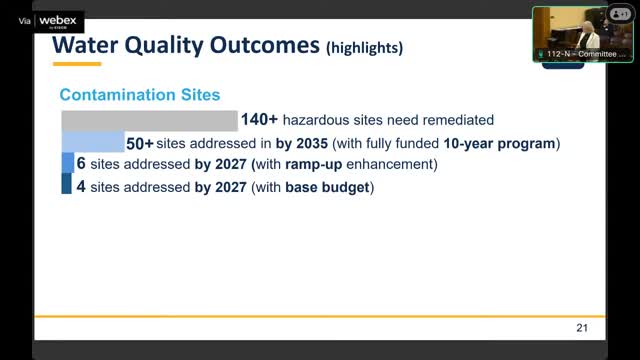Kansas outlines $90 million plan to secure 50 years of water supply for communities
January 23, 2025 | Committee on Agriculture and Natural Resources, Standing, HOUSE OF REPRESENTATIVES, Committees, Legislative, Kansas
This article was created by AI summarizing key points discussed. AI makes mistakes, so for full details and context, please refer to the video of the full meeting. Please report any errors so we can fix them. Report an error »

In a recent meeting of the Kansas House Committee on Agriculture and Natural Resources, officials gathered to address pressing environmental concerns, particularly the management of contaminated well sites and hazardous waste across the state. The discussions highlighted the urgent need for funding and strategic planning to tackle these issues effectively.
Kansas currently faces the challenge of over 140 hazardous waste sites, with plans to address only four of these by 2027 under the existing budget. However, with an enhanced funding proposal, the committee anticipates the potential to increase this number to six sites. Looking further ahead, a comprehensive ten-year plan could enable the state to remediate over 50 sites, significantly improving environmental safety.
The committee emphasized the importance of leveraging state investments to secure federal funding, with projections suggesting that a targeted investment could unlock a $25 million federal grant. This financial boost could be pivotal in addressing not only hazardous waste but also the maintenance of reservoirs that supply water to more than 1.7 million Kansans.
A key focus of the meeting was the concept of "50 years of water supply," a vision aimed at ensuring that every Kansas community has access to a sustainable water source. The committee discussed the necessity of developing plans that would allow communities to assess their water needs and resources over the next decade. For instance, towns like Leota and Sublette are grappling with dwindling water supplies, prompting urgent discussions about sourcing and transporting water.
The committee also recognized the need for independent evaluation of funding effectiveness, proposing an increase in budget allocation for this purpose. This move aims to ensure that taxpayer money is used efficiently and that the outcomes of environmental initiatives are measurable and transparent.
As the meeting concluded, the overarching message was clear: Kansas is at a critical juncture in its environmental management efforts. With strategic investments and community-focused planning, the state aims to secure a sustainable future for its water resources, ensuring that generations to come will have access to clean and reliable water supplies.
Kansas currently faces the challenge of over 140 hazardous waste sites, with plans to address only four of these by 2027 under the existing budget. However, with an enhanced funding proposal, the committee anticipates the potential to increase this number to six sites. Looking further ahead, a comprehensive ten-year plan could enable the state to remediate over 50 sites, significantly improving environmental safety.
The committee emphasized the importance of leveraging state investments to secure federal funding, with projections suggesting that a targeted investment could unlock a $25 million federal grant. This financial boost could be pivotal in addressing not only hazardous waste but also the maintenance of reservoirs that supply water to more than 1.7 million Kansans.
A key focus of the meeting was the concept of "50 years of water supply," a vision aimed at ensuring that every Kansas community has access to a sustainable water source. The committee discussed the necessity of developing plans that would allow communities to assess their water needs and resources over the next decade. For instance, towns like Leota and Sublette are grappling with dwindling water supplies, prompting urgent discussions about sourcing and transporting water.
The committee also recognized the need for independent evaluation of funding effectiveness, proposing an increase in budget allocation for this purpose. This move aims to ensure that taxpayer money is used efficiently and that the outcomes of environmental initiatives are measurable and transparent.
As the meeting concluded, the overarching message was clear: Kansas is at a critical juncture in its environmental management efforts. With strategic investments and community-focused planning, the state aims to secure a sustainable future for its water resources, ensuring that generations to come will have access to clean and reliable water supplies.
View full meeting
This article is based on a recent meeting—watch the full video and explore the complete transcript for deeper insights into the discussion.
View full meeting
